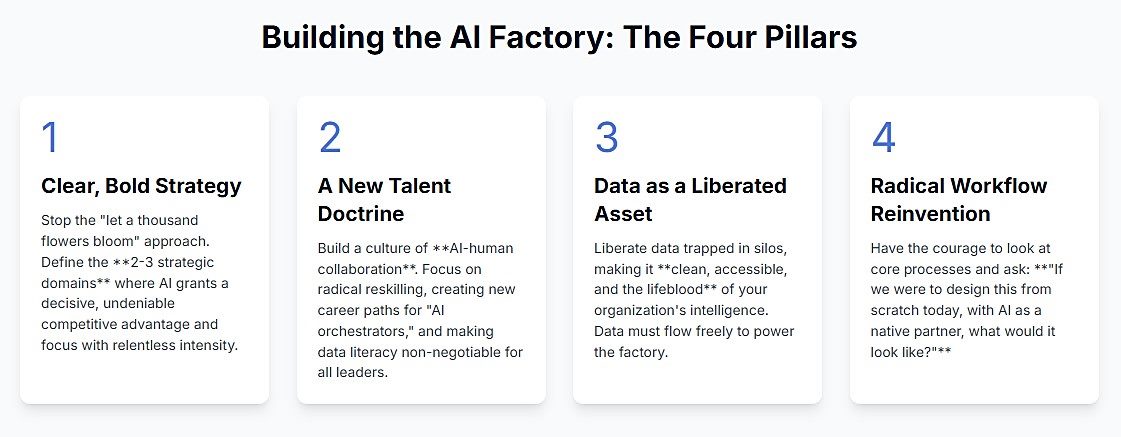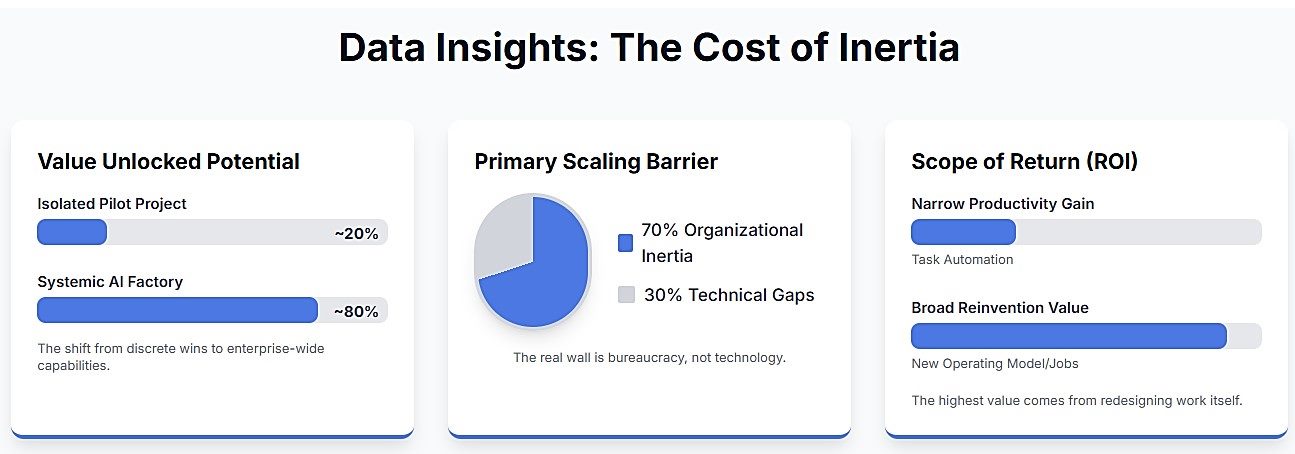Key Takeaways
- Your AI pilot program is a dead end.
- The biggest barrier to AI isn't your tech; it's your bureaucracy.
- AI's real ROI isn't just productivity; it's the reinvention of work itself.
- Stop "experimenting" and start strategizing.
- This is a leadership test, not an IT project.
I've spent months analyzing the real-world data from 100 healthcare companies at the forefront of AI adoption. The conclusion is both exhilarating and terrifying.
The AI hype is over. The era of cute pilot projects and isolated "wins" is finished. We are now entering the hard, gritty, unglamorous phase of total enterprise transformation. The biggest barrier to AI's promise isn't the technology; it's your bureaucracy, your outdated management orthodoxies and your lack of courage to reinvent how work gets done. This is no longer a test of your IT budget; it's a test of your leadership.
AI Isn't an IT Project. It's a Mandate to Reinvent Your Management Model.
For the past two years, we've been living through an AI-fueled carnival of wonders. We've marveled at the demos, celebrated the productivity hacks and launched a thousand pilot programs. It has been a grand "science fair," a showcase of technological novelty. But now, the carnival is leaving town.
The hard, sober light of day is upon us, and with it, a stark reality check, powerfully articulated in recent McKinsey analysis: the value of AI is not in the algorithm, but in the audacity to rewire the very core of your enterprise.
The data is clear. While GenAI is delivering real productivity gains, these benefits are heavily concentrated in a few functions. The biggest barrier to getting broader value isn't a lack of better models; it's a profound lack of organizational readiness. We are trying to pour the liquid-metal dynamism of AI into the rigid, brittle molds of our 20th-century management systems. It will not work. It's time to stop admiring the science projects and start building the AI factory.
Related Article: Beyond the Hype: The Hard Realities of AI's Cost, Control and Coming Correction
The Great Stagnation: Why Your AI Pilots Are Going Nowhere
Let's be honest about why so many of your AI initiatives are stuck in "pilot purgatory." It's not because the tech isn't good enough. It's because you've treated AI as an IT project, not as a mandate to challenge your assumptions about how your organization works.

Your pilots are failing to scale because they are colliding with the concrete walls of your bureaucracy. They are being smothered by the antibodies of the old guard.
You've asked your people to "experiment" without giving them the air cover to challenge sacred cows. You've celebrated a 15% efficiency gain in a single department, while ignoring the systemic friction that makes your entire enterprise 50% less effective than it could be.

From Tinkering to Transformation: Building the AI Factory
What's the alternative? You must shift your mindset from running isolated experiments to building an enterprise-wide "AI factory." This isn't just a metaphor for a tech stack. It is a new management system, a new logic for how your organization learns, decides and creates value. It requires a new operating model for the AI era.

This means getting serious about the unglamorous, foundational work:
- A Clear, Bold Strategy: Stop the "let a thousand flowers bloom" approach. You must define the 2-3 strategic domains where AI will give you a decisive, undeniable competitive advantage and focus your resources there with relentless intensity.
- A New Talent Doctrine: The talent gap is real. You need to stop thinking about "hiring AI people" and start thinking about building a culture of AI-human collaboration. This means radical reskilling, creating new career paths for "AI orchestrators" and making data literacy a non-negotiable for every leader.
- Data as a Liberated Asset: Your data is likely trapped in silos, a prisoner of departmental fiefdoms. Building the AI factory requires liberating this data, making it clean, accessible and the lifeblood of your organization's intelligence.
- Radical Workflow Reinvention: This is the hardest part. It means having the courage to look at a core process, be it drug discovery in pharma, patient intake in a hospital or claims processing in insurance, and asking, "If we were to design this from scratch today, with AI as a native partner, what would it look like?"
The Human Imperative: Beyond Productivity to Reinvention
The most profound mistake leaders are making is seeing AI through the narrow lens of productivity. The goal isn't just to make a clinician 15% faster at filling out an EHR. The goal is to reinvent the very nature of a clinician's work.

Imagine a doctor, freed from the tyranny of the keyboard by an ambient AI scribe. Her time is liberated from clerical drudgery. Now what? Does she simply see 15% more patients in the same old 15-minute slots? Or do you, as a leader, have the imagination to redesign her role? Perhaps she now spends that reclaimed time on complex case analysis with an AI diagnostic partner. Perhaps she dedicates it to longer, more empathetic patient conversations that build trust and improve adherence. Perhaps she becomes a mentor, a researcher a local health advocate.
AI's greatest gift is not the automation of tasks, but the liberation of human potential. But this potential is squandered if we don't have the courage to redesign the jobs, the roles and the performance metrics to match.
Related Article: From Coders to Conductors: The Shift to AI Orchestration
Are You Ready to Break the Status Quo?
The AI revolution is here, but it is not a technological revolution. It is a revolution in management, in leadership and in imagination. The data is clear: the value is there for the taking, but it is locked behind the doors of our own organizational inertia.
The choice before you is stark. You can continue to run your AI science fair, celebrating clever but inconsequential projects that never challenge the status quo. Or you can roll up your sleeves and begin the hard, essential work of building the AI factory. You can be a caretaker of a fading paradigm, or you can be the architect of a new one. The future of your enterprise, and perhaps your industry, depends on your answer.
FAQs
Learn how you can join our contributor community.
